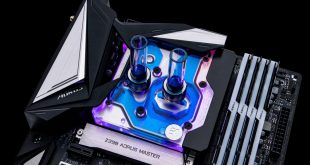As is the case with SB-E and Haswell chips, IVB-E features CPU clock straps which allow its native base clock to be multiplied by 1.00 and 1.25, or 1.67 if the chip supports it. Put simply, it allows the processors to operate at high base frequencies, such as 125MHz, without having negative implications on link speeds to the rest of the system's components.
Memory is also fed by the multiplied base frequency, giving it the potential to overcome a CPU's memory multiplier limits (as we will see later in the review).
Automatic CPU Overclocking – BCLK First:
Using the ‘BCLK First' automated overclocking mode, Asus' X79-Deluxe boots the i7 4960X CPU with a frequency of 4125MHz. The 4.125GHz CPU speed is achieved by way of 125MHz base clock (using the 1.25x CPU strap) and a 33x core ratio. Our 2133MHz Patriot memory was set to operate at 2000MHz with its default timings of 11-11-11-27-3T.
For this setting, Asus' motherboard used the ‘Auto' voltage parameters. With our system, this resulted in a CPU VCore of 1.280V for idle and load scenarios.
Automatic CPU Overclocking – Ratio First:
Using the ‘Ratio First' automated overclocking mode, the X79-Deluxe motherboard opted for a dynamic overclock which used varied turbo ratios and the standard 100MHz base clock. The maximum core ratio was 43x, with a 41x setting being applied when all cores were loaded. Memory was set to 1866MHz and the default timings, which is slightly disappointing, especially given that the CPU and motherboard both support the 2133MHz divider.
Under idle conditions, the CPU frequency would drop to 1200MHz (12 x 100MHz) and a voltage of around 1.168V. When a multi-core load was applied, the CPU frequency jumped to 4100MHz (41 x 100MHz) and voltage increased to around 1.344V.
With the applied load voltage, our Corsair H100i kept the CPU temperature in the low-60s. Lesser performing CPU coolers may have a tougher time taming the heat from a 1.344V VCore. A good-value, sub-£30 model, such as the Cooler Master Hyper 212 EVO, should be capable of keeping temperatures at a reasonable level.
Manual CPU Overclocking (1.00x CPU Strap):
In order to push for the maximum frequency of our 4960X engineering sample chip, we applied a number of power tweaks and voltage increases.
The tweaks we applied included; Extreme LLC, 140% CPU current capability, and Extreme CPU power duty and phase control. We also enabled PLL overvoltage and PLL Termination, and disabled CPU spread spectrum. A BIOS-set VCore of 1.425V was used – a value which peaked at 1.456V under heavy load.
The Asus X79-Deluxe motherboard managed to push our Intel Core i7 4960X EE sample to 4.60GHz by simply increasing the multiplier to 46x.
Despite being able to boot into Windows, we could not obtain stability at 4.70GHz, no matter how many power settings we tweaked. We tried a CPU VCore of 1.475V, PLL voltage of 2.00V, system agent voltage of 1.300V, and VTTCPU voltage of 1.15V, but we still could not garner stability at 4.70GHz.
Our best overclocking result (using the 100MHz base clock) was 4.60GHz (46 x 100MHz) at a BIOS-set voltage of 1.400V. This setting was perfectly stable and temperatures were acceptable for 24/7 usage with our Corsair H100i CPU cooler.
4.60GHz was also largely stable at 1.375V (in the BIOS), but Handbrake conversion tests repeatedly caused BSODs, hence why we settled for a 1.400V VCore.
The Asus X79-Deluxe motherboard sent 1.408V to the 4960X when idling. As soon as a load was applied, the processor's core voltage increased to a maximum of 1.424V.
We did manage 4646MHz using a 46 x 101MHz setting, but the memory multiplier had to be dropped (to stay below our sticks' 2133MHz rating), so performance gains from the extra 46MHz CPU frequency would be negated by the decreased RAM speed.
Our 4.6GHz validation can be viewed here. Unfortunately, the CPU-Z validator destroyed our link when uploading a later validation soon after.
Manual CPU Overclocking (1.25x CPU Strap):
Hoping to achieve a greater CPU frequency by using a high base clock and lower multiplier, we switched to the 1.25x CPU strap. All voltage and power settings remained the same as those using for the 1.00x strap (including the increased values when searching for the maximum stable frequency).
The memory speed was dropped to 2000MHz to eliminate RAM instabilities from the overclocking equation (and because 2133MHz is not possible with a 125MHz base clock).
Our highest stable clock speed using the 1.25x CPU strap was 4625MHz (37 x 125MHz). We tried to push past the 4650MHz barrier by using a 36 x 130MHz setting, but could not do so with our sample processor.
When a heavy load (such as Prime95) was applied to the processor, our settings for the Asus X79-Deluxe motherboard provided a maximum CPU VCore of 1.456V (1.425V BIOS-set). Temperatures were safe for 24/7 usage with our Corsair H100i.
A lower CPU VCore may have provided ample stability, but with decreased temperatures. We didn't search for the lowest stable VCore because the 4.60Ghz overclock using the 1.00x CPU strap was already more desirable due to the fact that our memory stayed at its rated speed of 2133MHz.
Our 4.625GHz (37 x 125MHz) validation can be viewed here. As can be seen by the 4.60GHz and 4.625GHz validations' identical codes and links, the CPU-Z validator would only allow us to link to the one that was updated last (the 4625MHz validation).
Asus X79-Deluxe Overclocking (SB-E):
Referring to the Asus X79-Deluxe motherboard's overclocking performance with SB-E, we also had no problems taking a retail 3930K processor to 5.0GHz with sensible voltage levels.
The system wasn't 100% stable at 5.0GHz (the odd benchmark would fail), but a little extra voltage and enhanced cooling would have solved BSODs.
 KitGuru KitGuru.net – Tech News | Hardware News | Hardware Reviews | IOS | Mobile | Gaming | Graphics Cards
KitGuru KitGuru.net – Tech News | Hardware News | Hardware Reviews | IOS | Mobile | Gaming | Graphics Cards


















